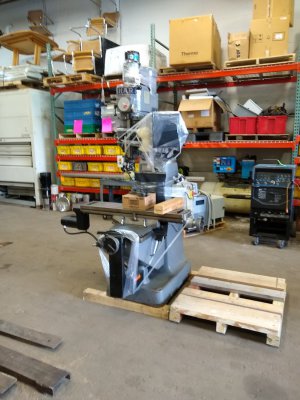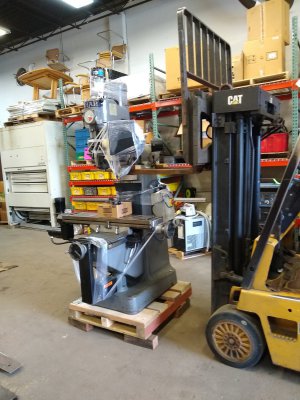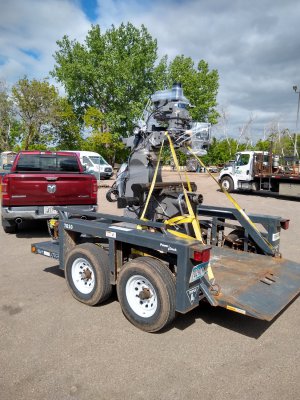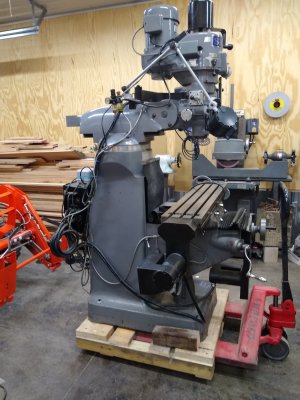The Lagun is a great mill. Agree with mmcmdl, if the table is 9x42, it's an FTV-1. I would not trust the lift eye on the top of the ram to lift the entire mill, ever. Fine for lifting the ram off the mill, but that is all. If you're going to hoist it, put a pair of chokers around the ram, one on each side of the turret. Or, if you have forks, pad them with thin plywood, and place the forks under the ram straddling the turret. It'll weigh well over 2000#. Closer to 24-2500.
-
Welcome back Guest! Did you know you can mentor other members here at H-M? If not, please check out our Relaunch of Hobby Machinist Mentoring Program!
You are using an out of date browser. It may not display this or other websites correctly.
You should upgrade or use an alternative browser.
You should upgrade or use an alternative browser.
Buying a Lagun mill... how do I move this thing?
- Thread starter joec2000
- Start date
- Joined
- Dec 24, 2020
- Messages
- 1,030
It looks like you've got advice on getting it out of the shop and onto the trailer. The big threat is transporting it on a trailer and not having a major issue. While a mill isn't extremely top heavy like a lathe or other machines you absolutely, positively, can not let it move at ALL during transport or it can topple when you hit a bump or have to swerve/brake hard because of some idiot on the road. Not pointing fingers, but 9 times out of 10 when we see pictures of people with machinery on trailers they aren't secured properly. It's actually easy, but not something most folks have seen before.
You want to secure the mill so that no matter which direction it wants to go, it's fighting a restraint. For starters, I like to run a chain with a binder across the base and use wood to protect the base. This keeps the mill on the deck so it can't bounce and shift. I then run 2" wide straps around the mill going to each corner of the trailer. Think of an X with the mill in the middle. It's important that the strap starts and ends at the same corner of the trailer, so RF corer, around the mill, back to the RF corner and repeat for each corner. Done this way, the mill has nowhere to go because it's always fighting a strap.
The most common error I've seen is people use two straps going to the back of the trailer corners, and only one going to the front corners. The thought is the threat is under braking, not acceleration. The problem with that is the front end of the mill can shift left or right, and as soon as that happens, one of the rear straps is loose. So if the front of the mill shifts two inches right, the right rear strap is now loose and bad things can happen.
I've got a couple of pics of what I'm talking about and will try to find them.
You want to secure the mill so that no matter which direction it wants to go, it's fighting a restraint. For starters, I like to run a chain with a binder across the base and use wood to protect the base. This keeps the mill on the deck so it can't bounce and shift. I then run 2" wide straps around the mill going to each corner of the trailer. Think of an X with the mill in the middle. It's important that the strap starts and ends at the same corner of the trailer, so RF corer, around the mill, back to the RF corner and repeat for each corner. Done this way, the mill has nowhere to go because it's always fighting a strap.
The most common error I've seen is people use two straps going to the back of the trailer corners, and only one going to the front corners. The thought is the threat is under braking, not acceleration. The problem with that is the front end of the mill can shift left or right, and as soon as that happens, one of the rear straps is loose. So if the front of the mill shifts two inches right, the right rear strap is now loose and bad things can happen.
I've got a couple of pics of what I'm talking about and will try to find them.
I have pictures of me moving my FTV-2. Let me look………..
Edit: no luck.
The seller used a forklift to load on my trailer. I used a chain hoist or 2 to unload. I pushed the mill across the floor on 1” pieces of black iron to it’s final location.
Edit: no luck.
The seller used a forklift to load on my trailer. I used a chain hoist or 2 to unload. I pushed the mill across the floor on 1” pieces of black iron to it’s final location.
Last edited:
- Joined
- Jan 7, 2016
- Messages
- 3,270
@joec2000 I did not realize that you started a new thread on moving this mill. I posted on your other thread on how I moved mine. I will copy and paste what I wrote over there into this post.
When I moved my Sharp mill from the rigging facility, I brought along a pallet that I made specifically for moving my mill. I built it out of a few 4x4's and LVLs for the planking, knowing that the mill was going to weigh around 3800 lbs or so. I had requested the bolt-hole pattern from the rigger so I could pre-drill the holes for the mounting bolts. Once there, the rigger simply lifted it with his forklift by placing the forks under the ram. Once it was high enough we slid the pallet under the mill and he slowly lowered it down while I ensured alignment with my mounting holes. I then bolted the mill down to the pallet and he proceeded to pick the mill up with the pallet and set it in the trailer.
Speaking of trailer, I would highly suggest renting a hydraulic ground-level trailer <<<LINK. Using one of these makes it sooooo easy. Once I was back at my shop I simply used a pallet jack to get it off of the trailer and into my shop. That being said, my mill is still sitting on the pallet for two reasons: 1.) I haven't quite figured out how I am going to safely lift it to get the pallet out. 2.) I like having the pallet and the ability to move the mill with my pallet jack (which I have done a couple of times.) One of our members built a really cool system to move his mill around. Look at this thread starting at post #106 by @firstram. <<< LINK
The most important part about a move like this is to take your time and think it through. You will do fine.
EDIT: Added some pictures of my moving my mill.
That is one of the bigger issues when dealing with our hobby machines. The big question is can the seller lift it? If he can, then a few obstacles are solved immediately.Now to figure out how to move it...
When I moved my Sharp mill from the rigging facility, I brought along a pallet that I made specifically for moving my mill. I built it out of a few 4x4's and LVLs for the planking, knowing that the mill was going to weigh around 3800 lbs or so. I had requested the bolt-hole pattern from the rigger so I could pre-drill the holes for the mounting bolts. Once there, the rigger simply lifted it with his forklift by placing the forks under the ram. Once it was high enough we slid the pallet under the mill and he slowly lowered it down while I ensured alignment with my mounting holes. I then bolted the mill down to the pallet and he proceeded to pick the mill up with the pallet and set it in the trailer.
Speaking of trailer, I would highly suggest renting a hydraulic ground-level trailer <<<LINK. Using one of these makes it sooooo easy. Once I was back at my shop I simply used a pallet jack to get it off of the trailer and into my shop. That being said, my mill is still sitting on the pallet for two reasons: 1.) I haven't quite figured out how I am going to safely lift it to get the pallet out. 2.) I like having the pallet and the ability to move the mill with my pallet jack (which I have done a couple of times.) One of our members built a really cool system to move his mill around. Look at this thread starting at post #106 by @firstram. <<< LINK
The most important part about a move like this is to take your time and think it through. You will do fine.
EDIT: Added some pictures of my moving my mill.
Attachments
Last edited:
- Joined
- Dec 24, 2020
- Messages
- 1,030
Here are a couple of pics to describe the 4-point method. I was loading this at an auction site and the rigging company guy was one I'd used in the past. He walked over to see how I was doing as I finished up and said "oh, that's not going anywhere!" so I was pretty confident it was fine. I didn't even invert the head as I was sure it was solid and there isn't much weight in the head really.
If you do invert the head, have one person support it as you turn the bolt that moves it...the gear isn't all that robust and you don't want it holding all the weight of the head as it rotates.


If you do invert the head, have one person support it as you turn the bolt that moves it...the gear isn't all that robust and you don't want it holding all the weight of the head as it rotates.
- Joined
- Jan 31, 2016
- Messages
- 11,446
I'm sure I have pics of moving all equipment . One thing not mentioned was a Johnson Bar , similar to the HF bar but larger . I would stay clear of pipes or skates as they aren't needed . The mill will slide easily across the floor once moving . Not really a lot of friction going on . Its easier to get it on the trailer than to get it off . Sometimes gravity hurts you if not paying attention , but I don't think you'll have any issues .I have pictures of me moving my FTV-2. Let me look………..
Edit: no luck.
Dab , got your message also , get back after the game .
- Joined
- Nov 25, 2015
- Messages
- 8,298
You may not get the loader in, but you can back the drop deck in with your truck, and use a winch, chain fall, or come along to pull it onto the drop deck, just use a johnson bar to lift it over the beginning lip of the drop deck. Also keep some extra straps to keep it from falling as you are angling it onto the drop deck.
I just moved my Jet 9x49. 2300#s Had a forklift to lift it onto a car carrier. If hadn't had the free use of that trailer & forklifts I'd have rented a drop deck trailer and used a winch of some sort. Binder chains across the bottom, 2" ratchet straps 4 ways. Used the lifting eye on the top of the mill as per the owner's manual. I had lowered the table and rotated the head. At the storage facility had the use of a forklift to get it off the trailer but the door was too low to go in. I have pipes but the mill bottom only bears on the corners so used pry bars to scoot it across the concrete. Slid easily.
The 1440 lathe, 3400#s, cast iron base, was moved by putting 1" steel bars through the holes made for the purpose in the base casting. Lifted using 2" ratchet straps with the forklift. At the storage facility we used pipes & pry bars to scoot it along on the concrete. I had plenty of help.
All my metal & woodworking stuff is in rental storage now. Waiting to get a 28 x 33' detached garage built in my side yard this spring. Being w/o my toys has been a traumatic experience, so bored. I spayed T9 on all bare metal and wiped it evenly over everything. Chucks and other bare metal have been T9'd wrapped in saturated paper and wrapped with stretch film and put in my very dry house basement. Moving shows just how much stuff has been accumulated over years.
The 1440 lathe, 3400#s, cast iron base, was moved by putting 1" steel bars through the holes made for the purpose in the base casting. Lifted using 2" ratchet straps with the forklift. At the storage facility we used pipes & pry bars to scoot it along on the concrete. I had plenty of help.
All my metal & woodworking stuff is in rental storage now. Waiting to get a 28 x 33' detached garage built in my side yard this spring. Being w/o my toys has been a traumatic experience, so bored. I spayed T9 on all bare metal and wiped it evenly over everything. Chucks and other bare metal have been T9'd wrapped in saturated paper and wrapped with stretch film and put in my very dry house basement. Moving shows just how much stuff has been accumulated over years.
Thank you so much, everyone! So many great ideas here! A lot to think about...
I didn't notice if the bottom of the mill was totally flat or if there was a space between any part of the base and the floor - to sneak a pry bar under. Are there typically pry points on these mills?Invest in a 5 ft. pry bar. Useful for getting pipe rollers etc. under the mill and positioning it once you get it close.

60 in. Pinch Point Bar
Amazing deals on this 60In Pinch Point Bar at Harbor Freight. Quality tools & low prices.www.harborfreight.com
I moved my mill solo, all the way from the front door, up over a 4 in. lip and to the back using pry bar, pipe rollers, chain, come-along and plywood ramp, screwing anchors into the sill plate of the garage for pull points.
I am trying to picture this... so 4x4 under the knee, maybe a jack stand under one end of the 4x4 and an automotive floor jack under the other end to lift up the front of the mill, little by little, and sneak some pipe under? I assume lifting this way won't damage the mill, correct?you can also lower the knee onto a piece of 4x4 to jack up the front, stick a piece of wood at the mid point of the base, then once you lower the mill back down you can rock it forward to put a piece of wood at the back of the base. Go up 1/2" or 1" at a time. Keep doing that until you can get some 3/4 or 1" black iron pipe under it and roll it to the front of the shop.
I hadn't even thought of this - very good point! Any recommendations on straps? Would it be better to use ratcheting straps here or use just any old 2" wide straps?It looks like you've got advice on getting it out of the shop and onto the trailer. The big threat is transporting it on a trailer and not having a major issue. While a mill isn't extremely top heavy like a lathe or other machines you absolutely, positively, can not let it move at ALL during transport or it can topple when you hit a bump or have to swerve/brake hard because of some idiot on the road. Not pointing fingers, but 9 times out of 10 when we see pictures of people with machinery on trailers they aren't secured properly. It's actually easy, but not something most folks have seen before.
You want to secure the mill so that no matter which direction it wants to go, it's fighting a restraint. For starters, I like to run a chain with a binder across the base and use wood to protect the base. This keeps the mill on the deck so it can't bounce and shift. I then run 2" wide straps around the mill going to each corner of the trailer. Think of an X with the mill in the middle. It's important that the strap starts and ends at the same corner of the trailer, so RF corer, around the mill, back to the RF corner and repeat for each corner. Done this way, the mill has nowhere to go because it's always fighting a strap.
The most common error I've seen is people use two straps going to the back of the trailer corners, and only one going to the front corners. The thought is the threat is under braking, not acceleration. The problem with that is the front end of the mill can shift left or right, and as soon as that happens, one of the rear straps is loose. So if the front of the mill shifts two inches right, the right rear strap is now loose and bad things can happen.
I've got a couple of pics of what I'm talking about and will try to find them.
- Joined
- Dec 24, 2020
- Messages
- 1,030
You definitely want something like a ratchet strap so you can get them tight. I usually tighten the front straps until they're somewhat tight and then tighten the back straps to really cinch things down. I'll drive a mile or two, stop and check that they're still tight and adjust as necessary (usually very little needed if you get it right from the start). Also, a piece of plywood or OSB under the mill will help as metal on metal isn't ideal for keeping things from moving.I hadn't even thought of this - very good point! Any recommendations on straps? Would it be better to use ratcheting straps here or use just any old 2" wide straps?
Most, maybe all, of my 2" straps are from TSC...nothing special, not particularly expensive but work perfectly.





